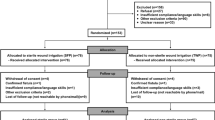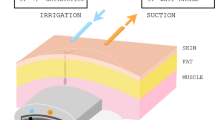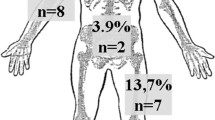Abstract
Background
Surgical debridement, negative-pressure wound therapy (NPWT) and antibiotics are used for the treatment of open wounds. However, it remains unclear whether this treatment regimen is successful in the reduction and shift of the bacterial load.
Methods
After debridement in the operating room, NPWT, and antibiotic treatment, primary and secondary consecutive microbiological samples of 115 patients with 120 open wounds with bacterial or yeast growth in ≥1 swab or tissue microbiological sample(s) were compared for bacterial growth, Gram staining and oxygen use at a level one trauma center in 2011.
Results
Secondary samples had significantly less bacterial growth (32 vs. 89%, p < .001, OR 17), Gram-positive bacteria (56 vs. 78%, p = .013), facultative anaerobic bacteria (64 vs. 85%, p = .011) and Staphylococcus aureus (10 vs. 46%, p = .002). They also tended to include relatively more Coagulase-negative Staphylococci (CoNS) (44 vs. 18%) and Pseudomonas species (spp.) (31 vs. 7%). Most (98%) wounds were successfully closed within 11 days, while wound revision was needed in 4%.
Conclusions
The treatment regimen of combined use of repetitive debridement, irrigation and NPWT in an operating room with antibiotics significantly reduced the bacterial load and led to a shift away from Gram-positive bacteria, facultative anaerobic bacteria, and S. aureus, as well as questionably toward CoNS and Pseudomonas spp. in this patient cohort. High rates of wound closure were achieved in a relatively short time with low revision rates. Whether each modality played a role for these findings remains unknown.

Similar content being viewed by others
References
Peinemann F, Sauerland S (2011) Negative-pressure wound therapy: systematic review of randomized controlled trials. Dtsch Arztebl Int 108:381–389
Evans D, Land L (2001) Topical negative pressure for treating chronic wounds: a systematic review. Br J Plast Surg 54:238–242
Morykwas MJ, Argenta LC, Shelton-Brown EI, McGuirt W (1997) Vacuum-assisted closure: a new method for wound control and treatment: animal studies and basic foundation. Ann Plast Surg 38:553–562
Osterhoff G, Zwolak P, Krüger C et al (2014) Risk factors for prolonged treatment and hospital readmission in 280 cases of negative-pressure wound therapy. J Plast Reconstr Aesthet Surg 67:629–633
Streubel PN, Stinner DJ, Obremskey WT (2012) Use of negative-pressure wound therapy in orthopaedic trauma. J Am Acad Orthop Surg 20:564–574
Timmers MS, Graafland N, Bernards AT et al (2009) Negative pressure wound treatment with polyvinyl alcohol foam and polyhexanide antiseptic solution instillation in posttraumatic osteomyelitis. Wound Repair Regen 17:278–286
Orgill DP, Manders EK, Sumpio BE et al (2009) The mechanisms of action of vacuum assisted closure: more to learn. Surgery 146:40–51
Timmers MS, Le Cessie S, Banwell P, Jukema GN (2005) The effects of varying degrees of pressure delivered by negative-pressure wound therapy on skin perfusion. Ann Plast Surg 55:665–671
Saxena V, Hwang CW, Huang S et al (2004) Vacuum-assisted closure: microdeformations of wounds and cell proliferation. Plast Reconstr Surg 114:1086–1096 (discussion 97–98)
Birke-Sorensen H, Malmsjo M, Rome P et al (2011) Evidence-based recommendations for negative pressure wound therapy: treatment variables (pressure levels, wound filler and contact layer)—steps towards an international consensus. J Plast Reconstr Aesthet Surg 64(Suppl):S1–S16
Armstrong DG, Lavery LA, Consortium DFS (2005) Negative pressure wound therapy after partial diabetic foot amputation: a multicentre, randomised controlled trial. Lancet 366:1704–1710
Lone AM, Zaroo MI, Laway BA et al (2014) Vacuum-assisted closure versus conventional dressings in the management of diabetic foot ulcers: a prospective case–control study. Diabet Foot Ankle 5:1–5
Assadian O, Assadian A, Stadler M, Diab-Elschahawi M, Kramer A (2010) Bacterial growth kinetic without the influence of the immune system using vacuum-assisted closure dressing with and without negative pressure in an in vitro wound model. Int Wound J 7:283–289
Mouës CM, Vos MC, van den Bemd GJ, Stijnen T, Hovius SE (2004) Bacterial load in relation to vacuum-assisted closure wound therapy: a prospective randomized trial. Wound Repair Regen 12:11–17
Lalliss SJ, Stinner DJ, Waterman SM et al (2010) Negative pressure wound therapy reduces pseudomonas wound contamination more than Staphylococcus aureus. J Orthop Trauma 24:598–602
Pinocy J, Albes JM, Wicke C, Ruck P, Ziemer G (2003) Treatment of periprosthetic soft tissue infection of the groin following vascular surgical procedures by means of a polyvinyl alcohol-vacuum sponge system. Wound Repair Regen 11:104–109
Deva AK, Buckland GH, Fisher E et al (2000) Topical negative pressure in wound management. Med J Aust 173:128–131
Yusuf E, Jordan X, Clauss M et al (2013) High bacterial load in negative pressure wound therapy (NPWT) foams used in the treatment of chronic wounds. Wound Repair Regen 21:677–681
Weed T, Ratliff C, Drake DB (2004) Quantifying bacterial bioburden during negative pressure wound therapy: does the wound VAC enhance bacterial clearance? Ann Plast Surg 52:276–279 (discussion 79–80)
Stannard JP, Volgas DA, Stewart R, McGwin G Jr, Alonso JE (2009) Negative pressure wound therapy after severe open fractures: a prospective randomized study. J Orthop Trauma 23:552–557
Patzakis MJ, Wilkins J (1989) Factors influencing infection rate in open fracture wounds. Clin Orthop Relat Res 243:36–40
Gosselin RA, Roberts I, Gillespie WJ (2004) Antibiotics for preventing infection in open limb fractures. Cochrane Database Syst Rev 1:CD003764
Halawi MJ, Morwood MP (2015) Acute management of open fractures: an evidence-based review. Orthopedics 38:e1025–e1033
Werner CM, Pierpont Y, Pollak AN (2008) The urgency of surgical débridement in the management of open fractures. J Am Acad Orthop Surg 16:369–375
Skaggs DL, Friend L, Alman B et al (2005) The effect of surgical delay on acute infection following 554 open fractures in children. J Bone Jt Surg Am 87:8–12
Schenker ML, Yannascoli S, Baldwin KD, Ahn J, Mehta S (2012) Does timing to operative debridement affect infectious complications in open long-bone fractures? A systematic review. J Bone Jt Surg Am 94:1057–1064
Fernandez R, Griffiths R (2012) Water for wound cleansing. Cochrane Database Syst Rev 2:CD003861
Crowley DJ, Kanakaris NK, Giannoudis PV (2007) Irrigation of the wounds in open fractures. J Bone Jt Surg Br 89:580–585
Edwards CC, Simmons SC, Browner BD, Weigel MC (1988) Severe open tibial fractures. Results treating 202 injuries with external fixation. Clin Orthop Relat Res 230:98–115
Artz CP, Sako Y, Scully RE (1956) An evaluation of the surgeon’s criteria for determining the viability of muscle during débridement. AMA Arch Surg 73:1031–1035
Osterhoff G, Spirig J, Klasen J et al (2014) Perforation and bacterial contamination of microscope covers in lumbar spinal decompressive surgery. Med Princ Pract 23:302–306
Grauhan O, Navasardyan A, Hofmann M et al (2013) Prevention of poststernotomy wound infections in obese patients by negative pressure wound therapy. J Thorac Cardiovasc Surg 145:1387–1392
Cattoir V, Nordmann P (2009) Plasmid-mediated quinolone resistance in gram-negative bacterial species: an update. Curr Med Chem 16:1028–1046
Kim PJ, Attinger CE, Steinberg JS et al (2014) The impact of negative-pressure wound therapy with instillation compared with standard negative-pressure wound therapy: a retrospective, historical, cohort, controlled study. Plast Reconstr Surg 133:709–716
Al-Mayahi M, Cian A, Lipsky BA et al (2015) Administration of antibiotic agents before intraoperative sampling in orthopedic infections alters culture results. J Infect 71:518–525
Bedenčič K, Kavčič M, Faganeli N et al (2016) Does preoperative antimicrobial prophylaxis influence the diagnostic potential of periprosthetic tissues in hip or knee infections? Clin Orthop Relat Res 474:258–264
Tetreault MW, Wetters NG, Aggarwal V et al (2014) The Chitranjan Ranawat Award: should prophylactic antibiotics be withheld before revision surgery to obtain appropriate cultures? Clin Orthop Relat Res 472:52–56
Levy PY, Fournier PE, Fenollar F, Raoult D (2013) Systematic PCR detection in culture-negative osteoarticular infections. Am J Med 126:1143.e25-33
Seidel D, Lefering R, Neugebauer EA (2013) Treatment of subcutaneous abdominal wound healing impairment after surgery without fascial dehiscence by vacuum assisted closure™ (SAWHI-V.A.C.®-study) versus standard conventional wound therapy: study protocol for a randomized controlled trial. Trials 14:394
Acknowledgements
A similar version of this abstract (“Bacterial Reduction and Community Shift with Negative-Pressure Wound Therapy: The Relevance of Surgical Debridements in the Operating Room”) was presented as an oral presentation at the 16th European Congress of Trauma and Emergency Surgery (ECTES) of the European Society for Trauma and Emergency Surgery (ESTES) in May 2015 in Amsterdam, The Netherlands. We would like to thank Dr. med. Florian P. Maurer for his advice as well as Dr. med. Matthias A. König, Ms. Verena Wilzeck, and Ms. Carmen Krüger for their help with data acquisition.
Author information
Authors and Affiliations
Corresponding author
Ethics declarations
Conflict of interest
The authors declare that they have no conflict of interest.
Rights and permissions
About this article
Cite this article
Jentzsch, T., Osterhoff, G., Zwolak, P. et al. Bacterial reduction and shift with NPWT after surgical debridements: a retrospective cohort study. Arch Orthop Trauma Surg 137, 55–62 (2017). https://doi.org/10.1007/s00402-016-2600-z
Received:
Published:
Issue Date:
DOI: https://doi.org/10.1007/s00402-016-2600-z




